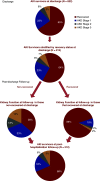AKI in Hospitalized Patients with COVID-19
- PMID: 32883700
- PMCID: PMC7894657
- DOI: 10.1681/ASN.2020050615
AKI in Hospitalized Patients with COVID-19
Abstract
Background: Early reports indicate that AKI is common among patients with coronavirus disease 2019 (COVID-19) and associated with worse outcomes. However, AKI among hospitalized patients with COVID-19 in the United States is not well described.
Methods: This retrospective, observational study involved a review of data from electronic health records of patients aged ≥18 years with laboratory-confirmed COVID-19 admitted to the Mount Sinai Health System from February 27 to May 30, 2020. We describe the frequency of AKI and dialysis requirement, AKI recovery, and adjusted odds ratios (aORs) with mortality.
Results: Of 3993 hospitalized patients with COVID-19, AKI occurred in 1835 (46%) patients; 347 (19%) of the patients with AKI required dialysis. The proportions with stages 1, 2, or 3 AKI were 39%, 19%, and 42%, respectively. A total of 976 (24%) patients were admitted to intensive care, and 745 (76%) experienced AKI. Of the 435 patients with AKI and urine studies, 84% had proteinuria, 81% had hematuria, and 60% had leukocyturia. Independent predictors of severe AKI were CKD, men, and higher serum potassium at admission. In-hospital mortality was 50% among patients with AKI versus 8% among those without AKI (aOR, 9.2; 95% confidence interval, 7.5 to 11.3). Of survivors with AKI who were discharged, 35% had not recovered to baseline kidney function by the time of discharge. An additional 28 of 77 (36%) patients who had not recovered kidney function at discharge did so on posthospital follow-up.
Conclusions: AKI is common among patients hospitalized with COVID-19 and is associated with high mortality. Of all patients with AKI, only 30% survived with recovery of kidney function by the time of discharge.
Keywords: COVID-19; acute renal failure; clinical nephrology; dialysis.
Copyright © 2021 by the American Society of Nephrology.
Figures





Update of
-
Acute Kidney Injury in Hospitalized Patients with COVID-19.medRxiv [Preprint]. 2020 May 8:2020.05.04.20090944. doi: 10.1101/2020.05.04.20090944. medRxiv. 2020. Update in: J Am Soc Nephrol. 2021 Jan;32(1):151-160. doi: 10.1681/ASN.2020050615. PMID: 32511564 Free PMC article. Updated. Preprint.
Comment in
-
COVID-19-Associated Acute Kidney Injury: Learning from the First Wave.J Am Soc Nephrol. 2021 Jan;32(1):4-6. doi: 10.1681/ASN.2020101401. Epub 2020 Oct 28. J Am Soc Nephrol. 2021. PMID: 33115918 Free PMC article. No abstract available.
References
-
- Intensive Care National Audit & Research Centre : ICNARC report on COVID-19 in critical care, 2020. Available at: https://www.icnarc.org/DataServices/Attachments/Download/c31dd38d-d77b-e.... Accessed April 21, 2020
-
- Abelson R, Fink S, Kulish N, Thomas K: An overlooked, possibly fatal coronavirus crisis: A dire need for kidney dialysis. New York Times, 2020. Available at: https://www.nytimes.com/2020/04/18/health/kidney-dialysis-coronavirus.html. Accessed April 24, 2020
Publication types
MeSH terms
Grants and funding
LinkOut - more resources
Full Text Sources
Medical

